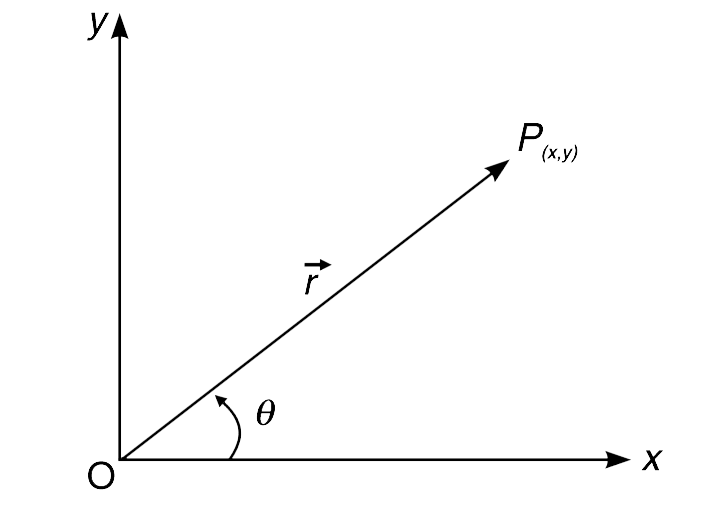A vector of length l is turned through the angle θ about its tail. What is the change in the position vector of its head ?
lcos(θ/2)
2lsin(θ/2)
2lcos(θ/2)
lsin(θ/2)
The correct Answer is:2
To solve the problem of finding the change in the position vector of the head of a vector of length l that is turned through an angle θ about its tail, we can follow these steps:
1. Define the Initial and Final Vectors:
- Let the initial position vector of the head be R1 and the final position vector after rotation be R2.
- Both vectors have the same magnitude, which is l.
2. Express the Change in Position Vector:
- The change in the position vector ΔR is given by:
ΔR=R2−R1
3. Use the Law of Cosines:
- To find the magnitude of the change in position vector, we can use the Law of Cosines:
|ΔR|=|R2−R1|=√|R1|2+|R2|2−2|R1||R2|cos(θ)
- Since |R1|=l and |R2|=l, we substitute these values into the equation:
|ΔR|=√l2+l2−2l⋅lcos(θ)
4. Simplify the Expression:
- This simplifies to:
|ΔR|=√2l2−2l2cos(θ)
- Factor out 2l2:
|ΔR|=√2l2(1−cos(θ))
5. Use the Trigonometric Identity:
- We know from trigonometric identities that:
1−cos(θ)=2sin2(θ2)
- Substitute this into the equation:
|ΔR|=√2l2⋅2sin2(θ2)
6. Final Simplification:
- This simplifies to:
|ΔR|=√4l2sin2(θ2)=2lsin(θ2)
Conclusion:
Thus, the change in the position vector of the head is:
ΔR=2lsin(θ2)
- Let the initial position vector of the head be R1 and the final position vector after rotation be R2.
- Both vectors have the same magnitude, which is l.
- The change in the position vector ΔR is given by:
ΔR=R2−R1
- To find the magnitude of the change in position vector, we can use the Law of Cosines:
|ΔR|=|R2−R1|=√|R1|2+|R2|2−2|R1||R2|cos(θ)
- Since |R1|=l and |R2|=l, we substitute these values into the equation:
|ΔR|=√l2+l2−2l⋅lcos(θ)
- This simplifies to:
|ΔR|=√2l2−2l2cos(θ)
- Factor out 2l2:
|ΔR|=√2l2(1−cos(θ))
- We know from trigonometric identities that:
1−cos(θ)=2sin2(θ2)
- Substitute this into the equation:
|ΔR|=√2l2⋅2sin2(θ2)
- This simplifies to:
|ΔR|=√4l2sin2(θ2)=2lsin(θ2)
Thus, the change in the position vector of the head is:
ΔR=2lsin(θ2)
Topper's Solved these Questions
- BOOK - ALLENCHAPTER - BASIC MATHEMATICS USED IN PHYSICS &VECTORS EXERCISE - EXERCISE-IV ASSERTION & REASON11videos
BASIC MATHEMATICS USED IN PHYSICS &VECTORS
- BOOK - ALLENCHAPTER - BASIC MATHEMATICS USED IN PHYSICS &VECTORS EXERCISE - EXERCISE-II AIPMT/NEET & AIIMS (2006- 2018)6videos
BASIC MATHEMATICS USED IN PHYSICS &VECTORS
- BOOK - ALLENCHAPTER - CENTRE OF MASSEXERCISE - EXERCISE-V B19videos
CENTRE OF MASS
Similar Questions
Knowledge Check
- Question 1 - Select One
A vector →A is rotated through angle θ about its tail. Change of position vector of its tip of is:
AAsinθB2Acos.θ2C2Asin.θ2DAcosθ - Question 2 - Select One
A vector of magnitude a is turned through angle θ . The magnitude of change in the vector is given by:
A|2asinθ|B|2asinθ/2|C∣∣∣a2sinθ∣∣∣D∣∣∣a2sinθ/2∣∣∣ - Question 3 - Select One
Let →a,→b,→c be unit vectors, equally inclined to each other at an angle θ,(π3<θ<π2). If these are the poisitions vector of the vertices of a trinalge and →g is the position vector of the centroid of the triangle, then:
A|→g|>1B|→g|≤√32C|→g|≥√32D|→g|≤√23
A vector →A of magniude (A) is turned through an angle θ. Calculate the cahng in the magniude of vector.
View SolutionA parallel-plate capacitor consists of two square plates of effective area A, length L and plate separation d. If one of the plates is turned through a small angle θ, what is the change in the capacitance of the capacitor?
View SolutionA particle has co-ordinates (x, y). Its position vector makes on angle θ with positive x direction. In an infinitesimally small interval of time the particle moves such that length of its position vector does not change but angle θ increases by dθ. Express the change in position vector of the particle in terms of x, y, dθ and unit vectors ˆi and ˆj.
 View Solution
View SolutionPosition vector and a vector in terms of position vectors of its end points
View SolutionThe bob of a pendulum of length l is pulled aside from its equilibrium position through an angle θ and then released. The bob will then pass through its equilibrium position with a speed v, where v equals
View Solution

